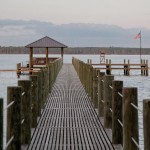
by Rick O'Connor | Feb 5, 2016
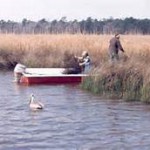
Fishermen fish the marshes of Weeks Bay while a pelican looks on. Photo: WeeksBay.org
Mobile Bay?… part of the Florida panhandle?… Really?…
Well… yes… during the colonial period “West Florida” extended west to the Biloxi area and besides, all western panhandlers know we are really “lower Alabama”; we hear it a million times a year… so YES, it’s part of the Florida panhandle! We’ll go with it.
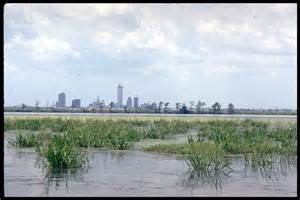
The shallow, muddy, and productive waters of Mobile Bay as they pass the port city of Mobile AL.
Photo: Auburn University
Approximately 35 miles long and 10 miles wide, Mobile Bay is one of the largest estuaries on the Gulf coast; draining close to 1/5th of the eastern United States. This wide, shallow, and muddy bay supports a variety of fresh and brackish water ecosystems. Wildlife from the Mississippi delta, the red hills of the Piedmont region, and the Florida panhandle all converge here making this one of the more biologically diverse areas in the country. It was home to both Dr. E.O. Wilson and Dr. Archie Carr who deeply loved the area and it has been a hub for estuarine research for decades. The rich abundance of wildlife supports commercial and recreational fishing and hunting as well as a growing ecotourism industry. Though the shallow bay must be dredged to support it, the Port of Mobile in one of the busiest in the Gulf region.
Weeks Bay is a small tributary to this bay system. Fed by the Fish and Magnolia Rivers on the southeastern shore of Mobile Bay, Weeks Bay discharges into Bon Secour, which supports a commercial fishing business. Lined with salt marshes, cypress swamps, and bogs, this area is great for wildlife viewing and fishing. It is also the area of Mobile Bay that experiences the famous crab jubilees; where levels of low dissolved oxygen on the bottom of the bay force benthic animals – such as crabs and flounder – to shallow water seeking oxygen. About 6,000 acres of this estuarine habitat is now part of NOAA’s National Estuarine Research Reserve system. At the reserve there are interactive exhibits, trails, and pontoon boat rides to explore and appreciate this special place.
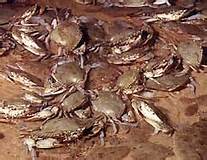
Crab jubilees occur along the eastern shore of Mobile Bay during very warm summer evenings.
Photo: NOAA
What better place to learn about the estuaries of the Gulf coast! The Panhandle Outdoor LIVE program will conduct one of our four 2016 watershed schools at this reserve. We will have lectures on estuarine ecology, the seafood industry in Mobile Bay – highlighting oyster farming, and on the mission of the Research Reserve itself. We will also have a local outfitter lead a kayak/canoe trip through the estuary as well an interpretive nature hike at the reserve’s visitor center. It will be set up as an overnight trip for those traveling and we will be staying at Camp Beckwith, which on Weeks Bay. Registration for this trip will open at the end of February. If you have questions about this watershed school you can contact Carrie Stevenson or Rick O’Connor at (850) 475-5230; or Chris Verlinde at (850) 623-3868.

A relaxing spot at Camp Beckwith on Weeks Bay.
Photo: Camp Beckwith
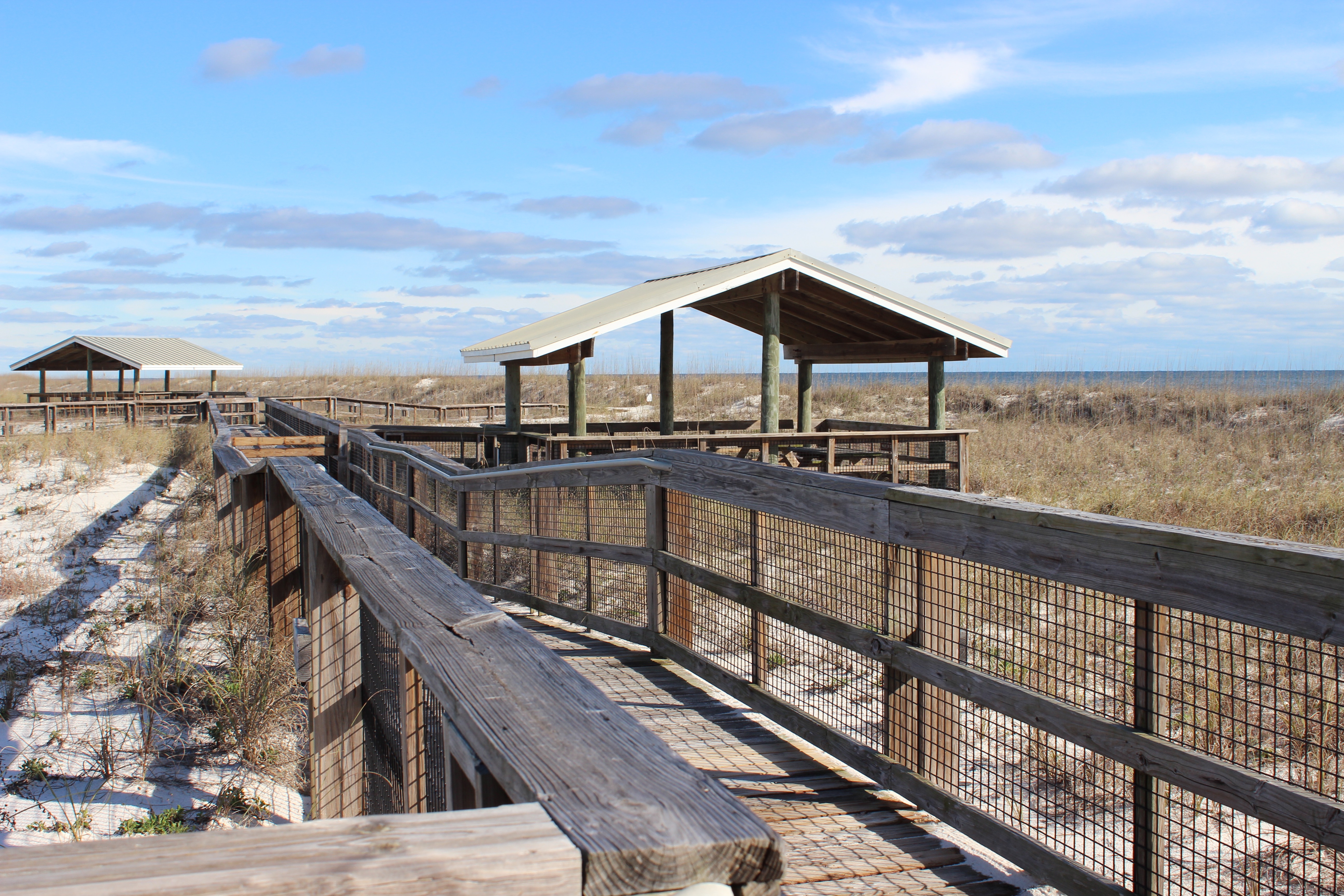
by Rick O'Connor | Jan 23, 2016
All photos: Molly O’Connor
More and more visitors to the Gulf coast are seeking nature encounters when on vacation. Of course there are still the amusement park fans but there is an increasing number interested in visiting “The Real Florida” that our state park system promotes. Actually, I have found that many lifelong residents of the Florida panhandle have not visited many of the scenic natural areas of our state.
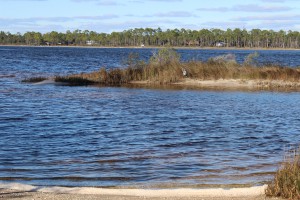
Looking from the kayak launch at Johnson’s Beach you can see across the ICW to Big Lagoon State Park. This body of water has seagrass and salt marshes along 12 miles of natural shoreline ending at an old fortification that can only be accessed by boat. There is plenty of snorkeling, birding, and fishing to do along the way.
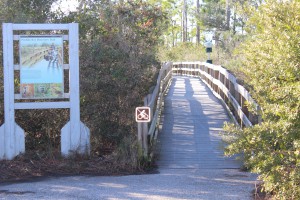
At the kayak launch at Johnson’s Beach is a short trail through the dunes of Perdido Key. You will be able to view a variety of plants and birds, or maybe, as I did, find a large coachwhip basking on a dune.
There is no doubt that to conserve something you need to love it… and to love it you need to experience it. We think if you visit some of our natural areas you will fall in love with the area and hopefully we can conserve much of it. Nature-based tourism is a way to support the local economy but we need natural areas for this to happen… fishing is not much fun without fish.
So we are going to begin a series of posts highlighting some of the nature-based tourism locations that visitors and locals can enjoy throughout the panhandle – from dunes of the coast to the forest of “north-end”. To begin the series, we will follow the Intracoastal Waterway from the Alabama state line to the Aucilla River (basically the Florida Panhandle). We begin at the western tip… Perdido Key. But first let’s talk about the Intracoastal Waterway itself.
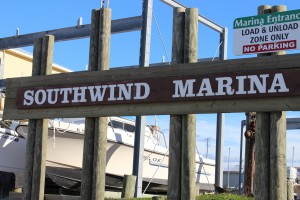
Southwind Marina is found on the northside of the ICW across from Perdido Key. For the visitor who is interested in fishing or diving the vessels can reach the Gulf in just a few minutes. Some dive charters will take you to spear lionfish.
INTRACOASTAL WATERWAY
The concept of the Intracoastal Waterway (ICW) dates back to the 19th century but construction on the northern Gulf section began in 1925. The ICW begins in Brownsville TX along the U.S. coastline to Carrabelle, FL. From here you follow a series of markers across the open Gulf to Anclote Key (near Tampa) where again the inland ICW heads to Ft. Myers. There is a canal that cuts across to Lake Okeechobee, and the east coast of Florida, but many boaters take the Florida Keys route. If crossing the state through the lake you will arrive at Jupiter Inlet on the east coast the ICW which travels north from here to Virginia – a total of about 3000 miles. The waterway was developed to make commercial shipping safer. Plans to cut a canal across north Florida from the Crystal River to the St. Augustine area never happened. The ICW consists of manmade canals, protected lagoons and sounds, and open sections of local bays.
In the Florida panhandle the ICW begins at the state line in Perdido Bay. It follows a narrow section of water north of what the locals call “Old River” between Ono Island AL and Innerarity Point FL. It eventually enters Big Lagoon in Escambia County before crossing the lower portion of Pensacola Bay. It is this portion of the ICW we will focus on in this article.
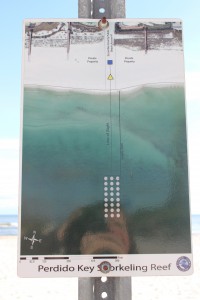
Escambia County Division of Marine Resources has provided three inshore snorkel reefs for the visitor who would like to experience a reef diving but is not a certified diver. The reefs can be found by aligning the blue square and yellow triangle on the beach. This one is on Perdido Key near Johnson’s Beach.
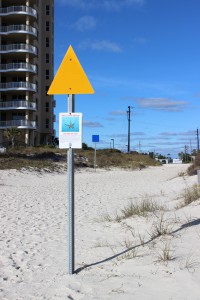
The yellow triangle used to locate the reef while you are swimming. These nearshore reefs have a variety of small reef fish and occasionally, in the warmer months, a sea turtle may visit.
PERDIDO KEY
Perdido Key is a 15-mile-long barrier island stretching from the mouth of Perdido Bay to “Ft. McRae” near NAS Pensacola in the Gulf Islands National Seashore. The western end is actually in Alabama. The state line is near Ono Island and the famous Flora-Bama Bar. North of the Key is “Old River”, then Ono Island AL, then the ICW itself, and eventually Innerarity Point FL. For the nature tourist you have miles of white sandy beaches to the south which are great for shell collecting, birding, and fishing. In the summer the beach comber can find ghost crabs, flowers, and maybe a nesting sea turtle. The “river” side of the island has numerous small islets and seagrass beds that offer good birding, snorkeling, and fishing. Be aware though to stay out of the ICW here. It is very narrow and the passing barges are very large. Dive flags are required of snorkelers in Florida. There is a public kayak launch on the north side along “Old River”. Perdido Key is home to the endangered Perdido Key Beach Mouse. Many locals have lived on the island all of their lives and have not seen one… maybe you will be lucky!
As Perdido Key Drive heads north off of the Key you will find a small side road leading to Johnson’s Beach and a section of the Gulf Islands National Seashore. Just as you turn onto Johnson’s Beach Road you will find Sandy Key Road to the south. There is a public access point here and a public nearshore snorkel reef provided by Escambia County. These Gulf side reefs attract a variety of small reef fish, including many tropicals, as well as larger species such as sheepshead and snapper. Be sure to have your dive flag with you.
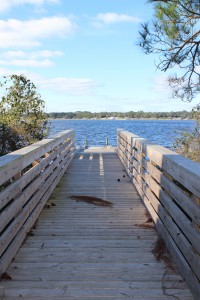
This public kayak ramp is found on the north side of Perdido Key. From here the paddler can visit several small islets and snorkel grassbeds. There’s good fishing too. The ICW is narrow here though so you need to be aware of large boat traffic.
The last 12 miles of Perdido Key is part of the Gulf Islands National Seashore. The road only goes about 2 miles of that but you are allowed to hike the rest. The southern shore is more beautiful white beaches and the north is bordered by Big Lagoon. Big Lagoon is pretty shallow and outside the ICW host a lot of seagrass. Here you can snorkel for hours and see fish, crabs, and maybe a scallop or two (they are illegal to harvest here though). Many species of birds can be found here including osprey. There is a short natural trail at the kayak launch on the lagoon side of the park where you can see a variety of dune plants, animal tracks (such as deer), and other wildlife such as coachwhip snakes and the elusive diamondback terrapin. You can paddle from the kayak launch 12 miles to the east point and “Ft. McRae”. Seagrasses, salt marshes, dunes, freshwater ponds, and assorted wildlife can be found here. Back Country Camping is allowed in this portion of the Seashore but you must register at the Ranger station.
As you leave Perdido Key you find Big Lagoon State Park on your right. Located on north shore of Big Lagoon you will find the ICW. This park provides camping, hiking, snorkeling, birding, and kayak rentals. The park has hiking trails and freshwater ponds that harbor a variety of wildlife including species of freshwater turtles. Just down Gulf Beach Highway you will find Southwind Marina, which is home to many charter boats. Also located on Big Lagoon these charters have quick access to offshore reefs in the Gulf of Mexico for those interested in diving and fishing, including trips to hunt the invasive lionfish.
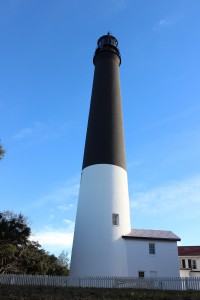
The 150′ Pensacola Lighthouse was first lit in 1859. The distinctive colors made it easy for mariners to identify from offshore and the light signal (time between flashes) is 21 seconds. This is a must see for those visiting the Perdido Key area.
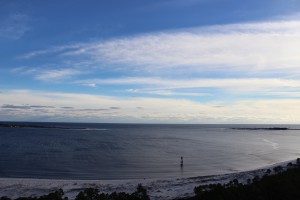
From the Pensacola Lighthouse you get a great view of the open Gulf and the eastern end of Perdido Key. Here the pass separates Perdido Key (on the right) and Santa Rosa Island.
Before you leave the Perdido Key area and head for Pensacola Beach the nature tourist should make a stop at NAS Pensacola. The 150 foot Pensacola Lighthouse is open to the public and the views of the ICW as well as the two barrier islands (Perdido Key and Santa Rosa Island) are wonderful. There is a nature trail aboard NAS called Trout Point which leads you from the main road to the ICW.
To learn more about nature trips in the Perdido Key area contact Sea Grant Agent Rick O’Connor at (850) 475-5230 or roc1@ufl.edu and to find local nature tours visit NaturallyEscaRosa.com
Next stop… Santa Rosa Island.
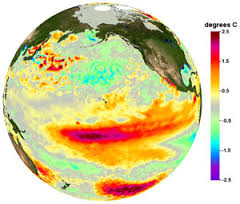
by Rick O'Connor | Jan 19, 2016
In our last article about the red tides we discussed how the strange weather of 2015 caused some changes in the natural world around Pensacola Beach – mainly, it got warmer. Though climate change is happening, and we just had a major summit on the topic in Paris, the warming of 2015 was most directly impacted by one of the strongest El Niño’s on record.
What is an El Niño?
It is a term most of us have heard and know it has something to do with the climate – that it is associated with warming – but little else about it. It is a climatic phenomena that has been occurring for centuries. It was first reported by Peruvian fishermen around Christmas time – hence the name El Niño (“the child”).
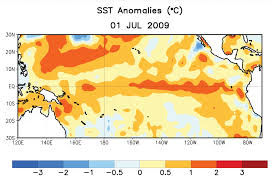
The red indicates warm water temperatures. Notice the warm temps in the eastern Pacific – not normal.
Graphic: NOAA
The ocean currents off the coast of Peru, and California, are quite cold – in the 55 F range. These cold currents move from the poles towards the equator along the coast. These cold currents keep the precipitation low and the air dry – “it never rains in Southern California”. Mountains and deserts are associated with these regions as well. The cool air at the top of the mountains flows down and across the landscape towards the ocean – causing the surface waters along shore to move offshore – thus creating a current from the ocean floor to rise to the surface called an upwelling. These upwellings bring with them an abundance of nutrients and, mixed with the high oxygen content of the colder water, provide a soup for plankton growth which is food for an abundance of fish – these are some of the richest fishing grounds in the world.
Every so many years the fishermen noticed the fish would disappear. It usually began around Christmas time and they would have to find another means to make a living until they returned – which they always did. They would note this in their log books and we know now that the El Niño would occupier every 7-11 years. Marine and climate scientists noticed that during these El Niño years other species would suffer and the climate would change – the El Niño was not just about fishing. Measurements showed that the current temperatures off of California and Peru warmed during El Niño years from 50 to 80 degrees! The upwelling would stop, the fish would leave, the seals could not feed their young, it rained in places where it normally does not rain, and drought would occur in other parts of the world. Coral reefs would suffer and other global climate changes would occur.

Warm water in the eastern Pacific indicates an El Nino season.
Graphic: NOAA
What they have discovered is that the cold ocean currents from the poles that pass California and Peru typically reach the equator and flow westward towards Indonesia and Australia. As the water moved along the equator it would warm producing the tropical reef world of Southeast Asia and the Great Barrier Reef. But during El Niño years this warm water begins to move eastward – back towards California and Peru. The cause is not fully understood yet. But the dry air of California becomes moist, rain falls, which effects the climate all across the country. One notable event locally is that most of the hurricanes are pushed upwards into the Atlantic and miss the Gulf of Mexico. The El Niño usually last a year. One other note here also. El Niño is typically followed by a year of drastic cooling – the La Niña.
How are the El Niño’s effected by climate change?
Some scientist believe the frequency of El Niño will not change but that the frequency of “super” El Niño’s will – they will increase. “Super” El Niño’s occurred twice in the last 20 years and the impacts on fishing, agriculture, and other human actives have been significant. The over all warming of the oceans will fuel a stronger warming event during an El Niño year. W are currently having the strongest “super” El Niño on record.
We will see what 2016 brings, it will be interesting. I know it is 70 degrees right now (December 28) and there are butterflies in my yard.
http://www.climatecentral.org/news/climate-change-could-make-super-el-ninos-more-likely-16976

by Rick O'Connor | Dec 21, 2015
Tis the season… the days are shorter, the lines at the stores are longer, and everyone is busy getting ready. This newsletter is about natural resources and nature – so I was thinking about how we could all enjoy the spirit of this holiday for the wildlife and for our own peace of mind. Maybe we could think in terms of the “12 days of Christmas” that could benefit wildlife and ourselves. Give it a try!
1st Day of Christmas: Donate to a Wildlife Sanctuary or a local Pet Shelter
This is a great way to start off. Most wildlife sanctuaries and animal shelters are need of items over the colder months. They are on tight budgets – as we all are – and giving is good for you as well. Providing a bag of pet food to our local animal shelter is another way to help our furry friends and it will make you feel better as well.
2nd Day of Christmas: Take a Walk Outside
This is one of the best times of year to live in the panhandle. The skies are beautiful day and night. The crowds are down and there are a lot of interesting things that walking our beaches and hiking in the woods. It is very calming in this season of busy and rush. Take a day (or evening) and enjoy it.
3rd Day of Christmas: Think About Bottled Water and other Plastic Items
We continue to find a lot of plastic items washed ashore along our beaches and roadsides that are serious problems for many of the organisms that live there. Plastic bottles, bags, and food wrappers (not to mention cigarette butts) are still collected each weekend along our beaches. Maybe this Christmas you can have some way of reducing these problems at your holiday gatherings. A good thing to continue throughout the year!
4th Day of Christmas: Participate in a Bird Count
There is the official Christmas Bird Count that occurs each year (find out more by contacting your local Audubon Society) or do one of your own while you enjoy the back porch. Much of the panhandle wildlife disappears this time of year – birds are one of the few that remain active (if not more active). You’ll be amazed at the variety we have here this time of year.
5th Day of Christmas: Consider Removing Invasive Species
Not everyone has these in their yard but some do. Some species have become a real problem and controlling them is a need. If you have an invasive plant consider removing it. If you need advice on how – contact us here at the Extension Office. Let’s try and keep the serious invasive species at bay.

There is nothing like Christmas lights on a tree.
Photo: Molly O’Connor
6th Day of Christmas: Go Paddle Boarding or Kayaking
It is a bit cold for most of us to enter the water this time of year but the waters are usually pretty calm and very clear. There are a lot of neat things you can see from a paddle boards or kayaks. Don’t have a paddle board or kayak? There are plenty of locations in the panhandle that rent them – it will be worth the time and money to get out outside for a while.
7th Day of Christmas: Think About Packaging
It really is not Christmas without beautifully wrapped presents beneath the tree. But we tend to generate a lot of waste with packaging. Some items are not even used more than the time it takes us to drive home – then they go straight into the trash can. We need color to make the season bright but take some time to think about how you could reduce the packaging issue.
8th Day of Christmas: Go Fishing
Even if you do not fish – or are real bad at catching fish – fishing is a very relaxing way to spend a few hours during the busy holiday. Who knows – You might catch a big surprise! Be aware of monofilament though. This is a big issue for aquatic wildlife also. There are monofilament recycle bins at many locations in the panhandle and boxes from Berkley Fishing Line that will recycle this line into other products.
9th Day of Christmas: Help the Sea Turtles
It is not sea turtle season yet but now is not a bad time to begin thinking about changing your outdoor lights to become more turtle friendly. Most of those living and working on the beach will have to make this change so why wait. If you have questions about how to become turtle friendly you can contact the county extension office.
10th Day of Christmas: Enjoy the Holidays Lights
This time of year we decorate our homes with beautiful Christmas lighting. It was common when I was a kid to take a ride one evening and just admire the lights – do it. It is really a great break from the hectic day. If you want to keep it traditional – hot chocolate when you are done!
11th Day of Christmas: Check for Derelict Crab Traps
This time of year the tides are lower than normal. Between the tide and the north winds – the water levels are low enough to expose derelict crab traps in the water. If you see one of these let us know here at the Extension Office. Removing crab traps from open waters (even if there are derelict) is illegal in Florida. We can get permission from the state to remove those. But we need to know where they are. Derelict traps unfortunately continue to catch crabs and other marine life – a waste of a good resource really – let’s change it.
12th Day of Christmas: Enjoy a Sunset
And finally – end your day with one of the best sunsets you will see all year. We are all lucky to live in a place like this. Celebrating the sunset is a wonderful way to be thankful for it.
Enjoy family, friends, pets, and wildlife this season. Take some time.
Happy Holidays Everyone!

by Rick O'Connor | Dec 21, 2015
This is a question I have been asked several times in the last week. As most of you know the red tide that has been occurring off the panhandle the last few months is still around. Dead fish were reported on Pensacola Beach again the weekend of Dec 12-13 and a few people said they were having eye and throat problems. This weekend I received a call of dead fish inside the bay but the caller was not suffering from eye and throat issues. Its December… what’s going on?
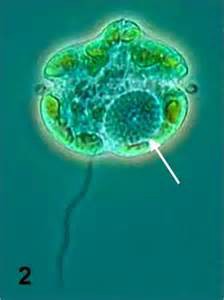
The dinoflagellate Karenia brevis.
Photo: Smithsonian Marine Station-Ft. Pierce FL
Well let’s look again at what red tide is and what facilitates the bloom. Red tide is caused by small microscopic plants called dinoflagellates. Dinoflagellates, like all plants, develop defense against herbivores that may try and feed on them. A few of these dinoflagellates release toxins when disturbed as a defense. They are in the Gulf all of the time but usually in low numbers, maybe 300 cells per liter of water, and cause no problems. But when conditions favor growth and reproduction they do just that – grow and reproduce – in great numbers, maybe 3000 cells per liter. When this happens the water actually darkens with their presence and the amount of toxin they release increases due to the increase number of cells – now marine creatures other than those that feed on them are impacted by the toxin – this is a red tide.
So, what are these conditions?
Well, like all plants dinoflagellates like sunlight, warm temperatures, and nutrients (fertilizers). So you would think that these blooms would occur when most plants grow – summer… and you would be right. There is another condition that contributes and those are currents. If currents are strong it will spread the bloom and the concentrations are spread as well, lowering the concentration per liter of water and thus reducing or diminishing the red tide.
We generally have plenty of sunshine here in the panhandle – temperatures are relatively warm, though they are warmer in south Florida – and there are nutrients. Nutrients are available naturally in the Gulf but are increased when we have a lot of rain as the runoff brings nutrients from land. But remember red tides are not always the result of human pollution – they occur naturally but can be increased or extended with excess nutrients from human runoff. The currents here along the panhandle tend to keep red tides at bay most of the time – we do not see them often here, but that is not the case with southwest Florida. In the Port Charlotte area red tides are more common part of life. It is warmer, there is more agriculture and municipal nutrients entering the Gulf, and the currents there are slower/weaker than we have here.
So what is up in the panhandle this year?
Well the sun is still shining! Feels great out there actually. The water temperatures were in the upper 60’s inside Pensacola Bay this week and that is typical, but the Gulf is still in the 70’s, and that is typical as well. What is not typical is the warmer air temperatures. This will slow the temperature drop of the Gulf and allow plants to extend their non-dormant season. H2O is a polar molecule (has an electric charge) and so the molecules are bonded together like two magnets. Because of this it takes more heat (energy) to warm the water and so area waters warm at a slower rate than the air. If the air temperatures remain warm it will be longer before the Gulf cools down. These warmer temperatures may extend the red tide a bit longer. As far as nutrients, heavy rains in October and November probably supplied more food for the plants and contributed to the beginning of the tide. Currents pushed the red tide inshore where we began to experience the eye problems and fish kills. The north winds from the recent fronts passing through may generate upwellings in the Gulf. Upwellings are currents that bring water from the ocean floor to the surface, this would bring nutrients with it. So we still have sun, warm temperatures, and nutrients – and the bloom is still with us. What will reduce the problem will be wind and currents to drive it offshore… and time – the Gulf will eventually cool and the tide will be reduced. How long is anyone’s guess.
So why is it 70 degrees in December?
That is a question for another article…
You can track red tides in the panhandle by visiting http://myfwc.com/REDTIDESTATUS




















